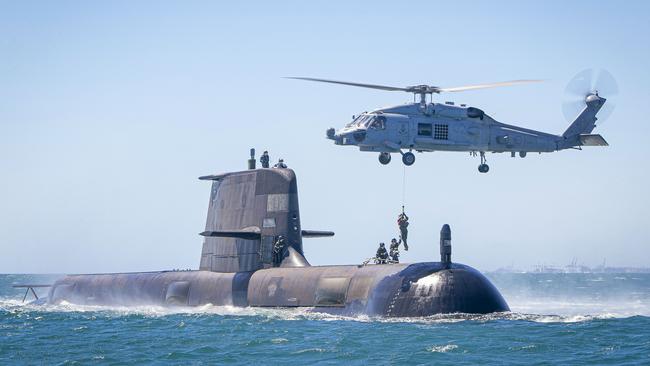Funding threat hangs over future submarine program
A contentious funding issue has become the latest problem to bedevil the RAN’s $90bn Attack-class Future Submarine program.

Although French shipbuilder Naval Group reassuringly advises that it is making significant progress in developing the design of the RAN’s Attack-class Future Submarine, a contentious funding issue has become the latest problem to bedevil the $90bn program.
As of mid-May this was continuing to be the subject of bitter contractual wrangling between Naval Group and Defence over the anticipated cost of work officially known as Core Workstate 2.
This involves basic design activities through to the Preliminary Design Review scheduled for May 2023. These activities continue work already undertaken under the Submarine Design contract signed in March 2019, with an initial workscope of $605m.
The scheduled work will provide detailed architecture for the hull structure and internal systems, including the placement of main systems, and will complete the functional design of the boat.
At the conclusion of the Preliminary Design Review, the first-of-type will have been defined and no changes to equipment or requirements that would affect the balanced design produced to that point could be accommodated without impacting cost and schedule.
The subsequent process will design systems in detail, integrating each zone to form detailed drawings for the whole submarine and develop the work instructions for pressure hull construction starting in 2024.
According to informed sources, the costings for Core Workstate 2 submitted by Naval Group were at least 50 per cent higher than the Defence estimate of $2.5-$3bn. This total included completion of the submarine construction yard being built at Osborne North by government-owned Australian Naval Infrastructure to the functional requirements of Naval Group.
Naval Group has declined to answer questions on the funding issue — or indeed on virtually anything else — but is understood to have submitted, without success, a much-reduced figure to Canberra.
Meanwhile, according to unconfirmed media reports, the government is refusing to pay Naval Group’s profit margin on work currently under way and the company is reportedly cutting costs and contractor support.
The funding issue gained prominence in March after Naval Group settled a longstanding irritant with the commonwealth and formalised an undertaking to spend in Australia at least 60 per cent of the value of its contracts.
This came after 12 months of tense negotiations and a breakthrough visit to Australia in February by the French company’s global chief executive Pierre-Eric Pommellet.
Pommellet’s intervention came amid reports that the commonwealth, concerned about project disputes, schedule, and costs, was considering walking away from the Sea 1000 contract under which Naval Group is to design and build 12 Attack-class conventionally powered, regionally superior submarines for the RAN.
Broader questions now hang over the Future Submarine Program and the maintenance of a viable Australian submarine capability
Although the 60 per cent issue has been settled, much broader questions to which the current financial dispute is contributing now hang over the Future Submarine Program and the maintenance of a viable Australian submarine capability.
These follow the tasking in February by Scott Morrison of Vice Admiral Jonathan Mead, Defence’s Chief of Joint Capability, and Commodore Tim Brown, Director-General of Submarine Capability, to examine options for the country’s submarine fleet.
Defence’s recent refusal to respond to media questions on submarine issues has contributed to speculation rather than the clarity that might seem preferable.
However, it’s understood that one option involves extensive rebuilds for the RAN’s six Collins-class boats starting in 2024, replacing a less comprehensive Life of Type Extension (LOTE) program currently scheduled to begin in 2026.
This would probably involve the submarines’ original designer and builder, Swedish company Kockums (now Saab-Kockums) working as strategic partners with government-owned Collins sustainers ASC (formerly the Australian Submarine Corporation).
This option would deliver four greatly enhanced Collins-class boats by 2032 and allow decommissioning of the first of the Collins-class fleet to be moved from 2026 to 2036; about two years after the first of the Attack-class is expected to enter service.
Rejected by Defence in 2015 as a potential Sea 1000 partner, Saab began discussions with ASC in 2020 on interfacing its ship control system which already equips the Collins-class with the new equipment likely to be involved in extending the Collins’ service life.
This includes new diesel generators, main motors, switching gear, and batteries.
Other upgrades already scheduled for the Collins fleet include new bow and flank sonar arrays, modernisation of the legacy communications centre, replacement of the electronic warfare system, wideband satellite communications, and possible replacement of a periscope with an optronics mast.
Further equipment eventually intended for the Attack-class would undoubtedly also be deployed on the upgraded Collins boats.
A second option is understood to involve Saab Kockums producing a scoping study for a “Son of Collins” boat based on the company’s extended range Expeditionary Submarine, on offer to replace the Royal Netherlands Navy’s Walrus class.
Such a move would provide a Plan B, the absence of which has been heavily criticised, should the commonwealth lose confidence in Naval Group.
Then-Defence Minister Linda Reynolds agreed in February 2020 to meet four times a year with her French counterpart Florence Parly to discuss Sea 1000 progress. Her replacement Peter Dutton has quickly stamped his authority on the Defence portfolio and can be expected to take a hard-nosed view of Sea 1000 difficulties, whether with Defence, industry, or Mme Parly.


